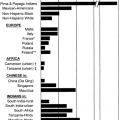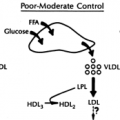Treatment of Diabetes in the Hospitalized Patient
Howard A. Wolpert
Diabetes-related hospitalizations in the United States totaled 13.9 million days in 1997 (1). The advances made in anesthesia and perioperative cardiovascular monitoring in recent years have led to a dramatic improvement in the outcome following major surgery in patients with diabetes (2). Too often, however, inattention to the metabolic management of the patient with diabetes will lead to complications in the hospital course and prolong hospital stay. Illness and surgery trigger counterregulatory hormone responses that counteract insulin action and can lead to metabolic instability and decompensation. In the hospitalized patient, host defenses against infection are compromised by disruption of the mucocutaneous barriers by endotracheal tubes, catheters, and surgical procedures. Furthermore, hyperglycemia directly inhibits immune function, adding to the risk for nosocomial infection. It is hoped that current trends toward the use of standardized treatment protocols to improve and expedite hospital care will have a positive impact on inpatient diabetes management.
TREATMENT CONSIDERATIONS: GOALS
Prevention of Metabolic Decompensation
The prevention of metabolic decompensation from the “stress” of illness and surgery is a key goal in the management of diabetes in the hospitalized patient. Surgery and illness induce a metabolic response that is characterized by increased secretion of epinephrine, glucagon, cortisol, and growth hormone (3,4). These counterregulatory hormones lead to a state of insulin resistance, with accelerated lipolysis and protein catabolism (5). In nondiabetic patients, there is a compensatory increase in insulin secretion that, in addition to maintaining glucose homeostasis, will counteract the catabolism and tissue breakdown. In the patient with diabetes, these counterregulatory changes can lead to metabolic decompensation with severe hyperglycemia and osmotic diuresis accompanied by dehydration and electrolyte disturbances. In patients with marked insulin deficiency, the increased levels of epinephrine and glucagon will trigger a state of accelerated lipolysis and ketogenesis that can culminate in diabetic ketoacidosis. The fundamental goal in the management of diabetes in the hospitalized patient is to ensure that there is sufficient circulating insulin to counteract this catabolic state.
Promotion of Wound Healing
The catabolic state that develops during injury and surgery can compromise the nutritional state of the patient and delay wound healing (6). Insulin has a key anabolic role in the physiologic responses that restrain tissue catabolism during injury. Studies in animal models of diabetes indicate that hyperglycemia and insulin deficiency attenuate the process of wound healing (7). The administration of insulin to injured nondiabetic patients markedly attenuates protein breakdown and urea generation (8,9). In addition, insulin therapy in the injured patient reduces the efflux of amino acids from skeletal muscle (10). Although there are no definitive data demonstrating that tight glycemic control improves wound healing in patients with diabetes, the weight of evidence showing that insulin blunts protein catabolism provides a strong physiologic rationale for
ensuring that the hospitalized diabetic patient has adequate insulin (11).
ensuring that the hospitalized diabetic patient has adequate insulin (11).
Minimizing Infection Risk
The answer to the question of how tightly to control hyperglycemia in the hospitalized patient depends on several considerations. Hyperglycemia has direct effects on immune function that can increase susceptibility to infection (12). Furthermore, the impaired phagocytic and bactericidal function of neutrophils from patients with poorly controlled diabetes is reversed with intensive glycemic control (13,14). Data from the Beth Israel Deaconess Medical Center, affiliated with the Joslin Clinic, clearly indicate that early postoperative glucose control is an important predictor of serious nosocomial infections such as bacteremia, pneumonia, and surgical wound infections (15). One hundred consecutive diabetic patients undergoing elective surgery over a 4-month period were prospectively followed for the development of postoperative infections. Patients with hyperglycemia (defined as at least one serum glucose measurement >220 mg/dL) on postoperative day 1 had an infection rate 2.7 times that noted in diabetic patients whose serum glucose measurements were all ≥220 mg/dL. Remarkably, when urinary tract infections were excluded from the analysis, hyperglycemia on postoperative day 1 was associated with a 5.8-fold increase in rates of nosocomial infection. These findings have been confirmed in an analysis from the Johns Hopkins institutions of postoperative infection rates in diabetic patients undergoing coronary bypass grafting (16). Postoperative glucose levels in the cohort were divided into quartiles and, independent of other factors, including underlying comorbidity and the severity of illness during the recovery, the patients in the lowest quartile (mean glucose level, 121 to 206 mg/dL) had lower infection rates.
Evidence from the Bypass Angioplasty Revascularization Investigation (BARI) (17) that patients with diabetes and multivessel coronary artery disease who receive internal mammary grafts have superior long-term survival compared with those who receive saphenous vein grafts or percutaneous transluminal coronary angioplasty has important implications with respect to perioperative diabetes management. Coronary bypass with internal mammary grafts has become the procedure of choice in patients with diabetes and multivessel coronary artery disease; however, this surgery is associated with a markedly higher incidence of postoperative deep sternal wound infections compared with saphenous vein grafting. In patients undergoing internal mammary grafting, the incidence approaches 11.5% to 14.3% (18,19), and there is a significant correlation between postoperative blood glucose levels and infection rates (20,21). Retrospective data from the St. Vincent Medical Center in Portland, Oregon, show that the implementation of a perioperative insulin infusion protocol in 1991 resulted in more than a 50% reduction in deep sternal wound infections (21). Mean blood glucose levels with the continuous insulin infusion protocol were significantly lower than those achieved prior to 1991 with subcutaneous insulin (199 ± 1.4 vs. 241 ± 1.9 mg/dL on the operative day; 176 ± 0.8 vs. 206 ± 1.2 mg/dL on postoperative day 1). During the period of analysis, the rate of deep sternal wound infections in the nondiabetic patient population remained constant, suggesting a causal link between the improved perioperative glucose control and reduced infection risk.
There is no definitive evidence from randomized controlled clinical trials demonstrating that tight glycemic control reduces rates of perioperative infection. However, the evidence that hyperglycemia directly impairs immune function and the weight of the empiric data showing a link between perioperative glycemic control and risk of infection provide support for a policy of aiming for blood glucose levels of less than 200 to 220 mg/dL in the surgical patient.
Risks of Hypoglycemia
The goal of avoiding hyperglycemia needs to be balanced against the increased risk of hypoglycemia associated with tight glycemic control. In the hospitalized patient with diabetes, the major concern related to hypoglycemia is the potential triggering of ventricular arrhythmias. Circumstantial evidence links hypoglycemia with sudden death in patients with diabetes, and experimental clamp studies have demonstrated that the epinephrine surges that occur with hypoglycemia can be accompanied by alterations in ventricular repolarization and ectopy (22,23). However, data from the Diabetes Mellitus Insulin Glucose Infusion in Acute Myocardial Infarction (DIGAMI) study suggest that the risks from hypoglycemia in the hospitalized diabetic patient are minimal. In this study, 306 patients with type 2 diabetes presenting with myocardial infarction (MI) were randomized to an intensive treatment protocol with an intravenous insulin-glucose infusion. Fifteen percent of these patients had at least one episode of hypoglycemia [predefined as a blood glucose level <3 mmol/L (54 mg/dL)], and none of these episodes were associated with any direct harmful effects (24).
Outcome Following Myocardial Infarction
The importance of intensive glycemic control in improving outcome following MI remains controversial. Patients with diabetes who have blood glucose concentrations ≥11 mmol/L at presentation of MI are at greater risk for in-hospital mortality (25). Although stress hyperglycemia may simply be a marker of the severity of illness, several plausible biologic mechanisms could account for this association. The relative insulin deficiency underlying the hyperglycemia will limit myocardial glucose uptake, and energy generation becomes increasingly dependent on free fatty acids, which are toxic to the ischemic myocardium (26). Moreover, the insulin deficiency will trigger lipolysis, thereby increasing circulating levels of free fatty acids. In addition, insulin deficiency leads to increased activity of plasminogen activator inhibitor type-1 (PAI-1), with a resultant impairment in fibrinolysis (27). In the DIGAMI study, the patients presenting with MI randomized to the intensive-treatment protocol with intravenous insulin had an improved outcome. However the subset analysis revealed that only those patients in the intensive-treatment arm who were categorized as low risk and who were not receiving insulin at presentation demonstrated this benefit (28). This raises the possibility that it was not the intensive management but rather the withdrawal of other diabetes therapies (such as sulfonylureas) that led to the improved survival after MI (29). Although the DIGAMI data do not unequivocally demonstrate that the tight peri-MI glycemic control per se accounted for the improved outcome, the intensive treatment regimen did not lead to any harmful complications in the study (24). The physician should consider use of an intravenous insulin infusion to maintain tight glycemic control if the MI patient is in a coronary care unit where intense monitoring allows the safe implementation of this regimen.
CONSIDERATIONS IN CLINICAL DECISION MAKING
Clinical decisions about how to manage diabetes in the hospitalized patient rest on several considerations.
Risks of Oral Agents in the Hospitalized Patient
Lactic acidosis is a rare, but serious, complication of metformin therapy, and this agent should be withheld from at-risk patients (30). The recommendation to withhold metformin includes the following conditions: radiologic procedures with dye loads (risk of renal impairment with delayed drug clearance), major surgery (risk of hypoperfusion with anaerobic metabolism and lactate generation), general anesthesia in patients with autonomic neuropathy (high risk of hypotension) (31), ischemic limbs (anaerobic metabolism and lactate generation), hepatic disease (impaired lactate metabolism), and cardiorespiratory failure with hypoxia.
Stay updated, free articles. Join our Telegram channel

Full access? Get Clinical Tree








